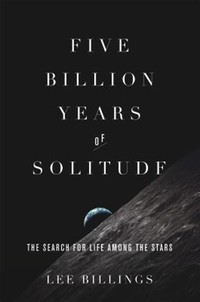Review: Five Billion Years of Solitudeby Jeff Foust
|
| There is, at times, a melancholy tone to this book, a perception that, just as we’re developing the ability to detect habitable worlds beyond our solar system, we’re in danger of abandoning that search. |
And it’s that caveat that lingers throughout the pages of Five Billion Years of Solitude, as Billings crisscrosses the country, talking to the leading scientists in exoplanetology and astrobiology. This book is, in some respects, something of a travelogue: Billings discusses the search for extraterrestrial intelligence (SETI) with Frank Drake at his home, witnesses the transit of Venus at Lick Observatory with astronomer Greg Laughlin, and walks along a lakeshore with atmospheric scientist James Kasting, discussing the habitability of extrasolar planets and how long our own Earth can support life. These passages are loosely bound into the book’s broader narrative of the search for other planets—itself a fascinating story full of competition and conflicts among astronomers—and the quest to find those that could support life, including intelligent life.
There is, though, at times more of a melancholy tone to this book, a perception that, just as we’re developing the ability to detect habitable worlds beyond our solar system, we’re in danger of abandoning, or at least indefinitely postponing, that search. The setbacks SETI has faced over the decades, from the loss of NASA funding two decades ago to more recent difficulties in keeping open a private radio observatory used for SETI searches, are relatively well known and chronicled in the book. Less well know, though, are the challenges astronomers face in trying to discover Earth-like exoplanets. Current telescopes are just now able to detect planets about the same size of the Earth and orbiting in their stars’ habitable zones, but determining if they are truly Earth-like, with liquid water and atmospheres and even biosignatures like oxygen and methane, require more advanced, larger, and more expensive instruments, most likely in space. As Billings describes in the book, thanks to budget constraints, and exacerbated by infighting among scientists as to the best approach to take, some of the most promising missions to detect real Earth analogs have been deferred indefinitely or cancelled outright.
Billings also conveys the perception that our time is limited: that we have a short window of opportunity to try and break that solitude. In the near-term, there are the various threats to our own civilization, from climate change to war, that could either wipe us out or deal a long-term setback on our efforts to study the universe. But even in the long-term, Billings notes that the Earth will not be habitable forever: we have, perhaps a half-billion to a billion years before the slowly brightening Sun renders the Earth uninhabitable. If we screw things up, there’s no guarantee life will get a second chance on Earth to ponder its place in the universe.
| “As precious as the Earth is,” Billings writes, “we can either embrace its solitude and the oblivion that waits at world’s end, or pursue salvation beyond this planetary cradle, somewhere far away above the sky.” |
However, that doesn’t mean that Five Billion Years of Solitude is a sad book. Far from it: Billings is a wonderful writer, and the book is full of eloquent, almost lyrical passages about the search for other worlds and other life. He will, at times, go on long digressions that first seem like irrelevant tangents, like an extended discussion of the Marcellus shale formation in Pennsylvania, only to reveal themselves as elliptical narrative trajectories that make their way back to the core of the book (in this case, the past and future habitability of the Earth.)
“As precious as the Earth is,” Billings writes, “we can either embrace its solitude and the oblivion that waits at world’s end, or pursue salvation beyond this planetary cradle, somewhere far away above the sky.” After reading Five Billion Years of Solitude, it will be tougher to embrace that solitude given the promise held by the discovery of hundreds or thousands of exoplanets so far, and untold more awaiting us just around the corner, if we’re willing to look.
